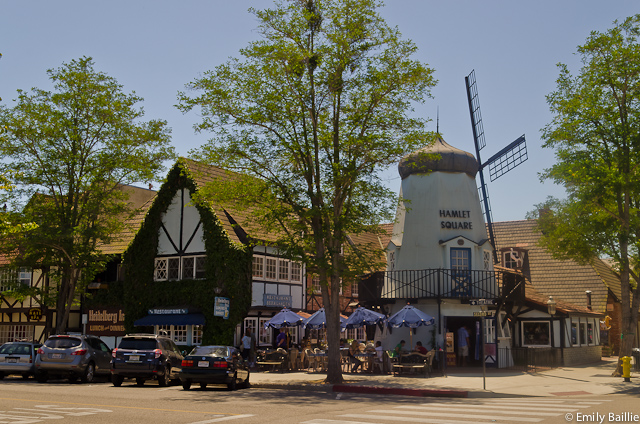
Old-fashioned windmills, medieval half-timber architecture, horse-drawn trolleys, and sticky-sweet Nordic shops aren’t your typical Southern Californian fare. But in the Golden State’s “Little Denmark,” they create a delightfully offbeat tourist experience that feels a world away.
Despite being surrounded by sunny cattle ranches, arid mountains, leafy palm trees and modern wineries, the town of Solvang feels like an old-world fairy-tale village. The majority of the buildings and homes in the town reflect Danish farm-style architecture, with brick and timber construction and real or fake thatched roofs. The flower-lined streets are filled with Danish pastry shops, kitschy gift shops, wine tasting boutiques, art galleries and charming patio restaurants.

The town’s red and white flag, modeled after the flag of Denmark, waves conspicuously under its street lamps, while a copy of Copenhagen’s famous “Little Mermaid” statue and a Hans Christian Andersen bust sit proudly on display. An open-air festival theatre hosts live performing arts events, a local book shop carries Danish language titles, and two museums – the Elverhøj Museum of History & Art and the Hans Christian Andersen Museum – are dedicated to Danish culture. Throughout the year, horse-drawn carts escort merry tourists around the town’s quiet streets, while Scandinavians of all sorts debate the town’s cultural authenticity.


Solvang’s unique architecture was imported by its Danish settlers. In 1911 a group of Danish teachers looking to escape the harsh midwestern winters, traveled to the Santa Ynez Valley and named the colony “Solvang,” meaning sunny fields. Glowing advertisements were placed in Danish-language newspapers and early land buyers, almost all Danish, came from California, the Midwest, and Denmark.


Starting in the 1930s, individual building projects in Solvang started to use bindingsværk architectural style. This type of construction was popular in Denmark as early as the 16th century. Literally meaning brick and timber, this half-timber construction technique (sometimes using stucco as an alternative to brick) is typical to Danish medieval buildings.
Because many residents could not afford real timbers, sculpted cement mixed with brown pigment often was used to create the impression of wood beams. More recently, older buildings were restyled to look Danish even if there was nothing Danish about them originally.

Solvang’s local mantra reportedly characterizes the town as “more Danish then Denmark.” According to the Elverhøj Museum of History & Art, people in Denmark are “familiar with and intrigued by the Danish community in California,” and make up a segment of the town’s one million annual visitors. Cultural festivals featuring Danish music and dance are held throughout the year, allowing Danish people to celebrate their heritage and tourists to enjoy a cultural experience found nowhere else in the state.


Though some believe the town’s authenticity to be only skin deep, its charm lasts at least long enough for a day’s visit. Only a short drive from Santa Barbara, a journey to Solvang feels like a brief trip abroad – no passport required.

Follow the author on Twitter @EmilyBaillie.





